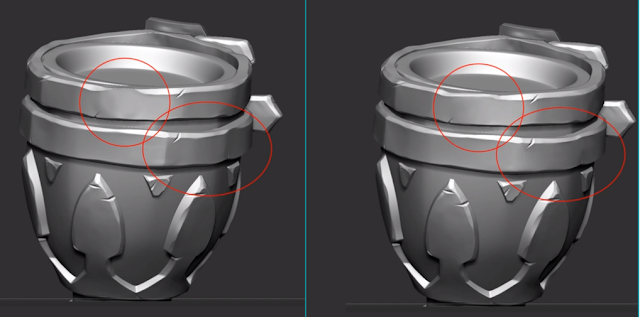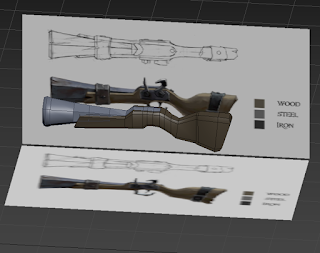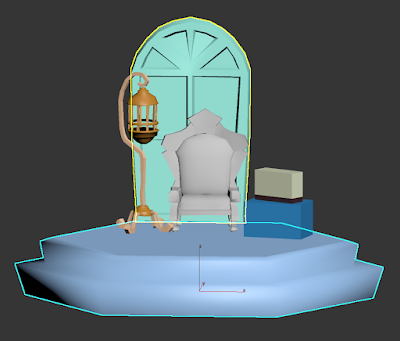PROJECT 1: Handpainted texturing
It would be no lie if I said I am terrified of this stage. My only previous encounter with purely handpainted texturing was in my first year (https://sketchfab.com/3d-models/lighthouse-diorama-8d33330436604496ac77b0aa7c6c0a9a) and though it did not end up being a disaster, I remember spending an ungodly amount of time on it before I made it look presentable.
To prepare myself as much as possible, I watched many tutorials by amazing artists and made a whole page full of notes. I also studied a lot of current Riot Games artists, such as Yekaterina Bourykina, Cody Bunt and Vlad Bacescu. The following is a mashup of all my notes I am sure I will come back to every time I texture before they're engraved in my long term memory. Disclaimer: it is probably very hard to orient in the notes as they're made mainly for my chaotic brain to understand, so if you're only interested in how my texturing went, please skip the wall of text and scroll down to see some screenshots! :)
NOTES
- Establish lighting - usually in LoL this would be top-down.
3D Coat Hotkeys and features to know mainly from here:
- 5: smooth shade
- 1: flat shade (always handpaint in this - fun fact, in my first year handpainted character project I had no idea this feature exists, painted the whooole thing up in Smooth Shade and then almost got a heart attack when exporting textures to Sketchfab and them not looking ANYTHING like the textures I saw in 3dCoat, fun times)
- Ctrl + P: view in Photoshop (When adjusting layers in PS, do not use folders as it rearanges the hierarchy when saved in 3DCoat)
- 0: Palette (pick colours from your reference directly)
- Set custom hotkeys by pressing END + Hotkey. Sliders like brush size can be adjusted in Windows > Sliders.
- The "eyeball" icon = super useful, hides your objects. Ctrl + X to get them back.
- If adjusting model in 3DsMax, replace the save and go to Import > Replace Geometry (make sure to keep same texture size)
- Edit > Edit Projection in External Editor -> MAGIC
- Caps Lock: Hides the yellow circle brush indicator
- Camera > Rotate around last draw point
Learned from: Texturing Metal with Form by Kelvin S Tan
- Block out design roughly but exactly (if you blur your eyes out from a distance a lot, all shapes should still read well together -> always keep large - medium - small on mind)
- Always think about the forms and check back on them. With metal, it's good to think about the bends and how they curve around things
- If you start working in colour, take print screens and desaturate in PS often to check values.
- It is okay to exaggerate values in handpainted style
- Paint highlights in edges to show where they come to a point, think about lighting - what direction is the plane facing? How intense will the light be?
- ZOOM OUT very often, make sure your model is readable both from up-close as well as from far away
(3dcoat brush preset, second one from the left hand side)
- When working on trims, follow your geometry as best as you can
- Do not render one thing out while leaving everything else behind. You want to have a cohesive lighting and for this you should aim to build it all together.
- My helmet will be brightest and lightest part of the model because it's receiving a the most light from top down.
- When painting trims, be consistent with their thickness around the whole model.
- AO is separate from the lighting. If an object in your model sits on another object, you need to paint the occlussion even if there's no direct light cast.
- Rendering metal: Starting with medium to darker values, adding color dodge when painting in colour (where things curve and bend) -> so paint metal when colouring? -> blending it together
- When adding highlights, the forms which are lower/more in shadow start with a more saturated highlight similar to the surface color, but as the highlight goes up, it blends into more desaturated version, closer to white
- Painting with confidence comes with practice - try using large or medium brush size more often, small looks blotchy
- Metalic highlight on wider form (1:01:30): squiggly lines, confident stroke, later blended into form. The smaller the spec is on the metal, the shinier it will seem (so if the highlight is very large, not centered and pointed, it will look like a less shiny metal)
- Common error: using black shadows, zoom out to check if they look black, if yes, add color in (purple is nice, blue maybe, look at your bounce light)
- Also, there should be less detail in shadow area - blend it in
- When/if designing, think of the gaps of your rythm - e.g. rather than having two larger shapes together, break it down with large, small, large or medium large small, etc.. Avoid things being split into equal parts (sometimes it's good, but most of the times it's better to vary things up).
- Don't be afraid to use multiple colour dodge layers when in later stages but always double check the intensity by zooming out
- When using masks (e.g. for gradient maps) in Photoshop, remember to merge the masked layers with whatever colour/base layer you have before you save as gradient maps themselves aren't recognized in 3DCoat
- Don't forget bounce lighting. Add colour from neighbouring objects to shadows or highlights.
- 2:26:40 Drag edit button: Time saver when duplicating. Click on "edit" to open the part in Photoshop.
- Rendering cloth (3:44:00): Start with base colour, then add darker value for areas between folds. Large medium small shapes. Keep brush bigger at start (airbrush preferred but bounce between airbrush/hardbrush in later stages of rendering). Darker value on sides of cloth to add depth. Think of the pinch points, where is the cloth being held together? Contrast lower, not as prominent as in metal, to add softer feel.
- During the polishing stages, mix in some colours (bounce, even random complimentary ones) to give it painterly feel and sense of wear & tear.
SCREENSHOTS
 |
| Early hair blockout |
 |
| Here I've received some great feedback from Miki, pushing me to add highlights and deepen some of the values. |



















